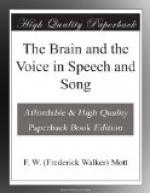[Description: FIG. 17.—Diagram to illustrate the Speech Zone of the left hemisphere (Bastian). This scheme is used to explain the mechanism of speech, but probably the centres are not precisely limited, as shown in the diagram; it serves, however, to explain disorders of speech. Destruction of the brain substance in front of the central fissure gives rise to what is termed Motor Aphasia and Motor Agraphia, because the patient no longer recalls the images of the movements necessary for expressing himself in articulate speech or by writing. Destructive lesions behind the central fissure may damage the portion of the brain connected with the mental perception of the sounds of articulate language, or the portion of the brain connected with the mental perception of language in the form of printed or written words—Sensory Aphasia; the former entails inability to speak, the latter inability to read.
This speech zone acts as a whole, and many disorders of speech may arise from destructive lesions within its limits. It has a special arterial supply, viz. the middle cerebral, which divides into two main branches—an anterior, which supplies the motor portion, and a posterior, which supplies the posterior sensory portion. The anterior divides into two branches and the posterior into three branches, consequently various limited portions of the speech zone may be deprived of blood supply by blocking of one of these branches. The speech zone of the left hemisphere directly controls the centres in the medulla oblongata that preside over articulation and phonation; innervation currents are represented by the arrows coming from the higher to the lower centres.]
These several cortical regions are connected by systems of subcortical fibres to two regions in front of the ascending frontal convolution (vide fig. 17), called respectively the “glosso-kinaesthetic” (sense of movement of tongue) and the “cheiro-kinaesthetic” (sense of movement of hand) centres. Now a person may become hemiplegic and lose his speech owing either to the blood clotting in a diseased vessel, or to detachment of a small clot from the heart, which, swept into the circulation, may plug one of the arteries of the brain. The arteries branch and supply different regions, consequently a limited portion of the great brain may undergo destruction, giving rise to certain localising symptoms, according to the situation of the area which has been deprived of its blood supply. Upon the death of the patient, a correlation of the symptoms observed during life and the loss of brain substance found at the post-mortem examination has enabled neurologists to associate certain parts of the brain surface with certain functions; but M. Marie very rightly says: None of the older observations by Broca and others can be accepted because they were not examined by methods which would reveal the extent of the damage; the only cases which should be considered




